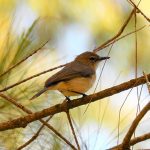LARGE-BILLED GERYGONE
Large-billed Gerygones are small birds with a distinctive large, slightly curved bill. They have a predominantly olive-green plumage, which helps them blend in with the foliage of the forests and woodlands they inhabit.
These birds are native to eastern and northern Australia, including parts of Queensland, New South Wales, and Victoria. They are also found in various regions of New Guinea.
Large-billed Gerygones inhabit a range of forested and wooded habitats, including rainforests, eucalyptus forests, and mangroves. They are often found in the canopy and mid-story of these forests.
They are known for their active and agile behavior, as they flit through the trees and shrubs in search of insects and other small invertebrates. They are also known for their melodious, high-pitched calls.
Their diet primarily consists of insects, spiders, and other small invertebrates. They forage for these prey items by gleaning from leaves and branches.
Large-billed Gerygones build small, cup-shaped nests in the vegetation. These nests are often well-camouflaged and are made of materials such as fine twigs, leaves, and spider webs. They lay a small number of eggs in their nests, and both the male and female share incubation and chick-rearing duties.
The conservation status of Large-billed Gerygones varies depending on their range. In some regions, they are considered of least concern, while in others, they face habitat loss and other threats. As with many bird species, their status can be influenced by local factors.
These small birds are known for their lively behavior and are a charming addition to the avian diversity of the regions they inhabit.




